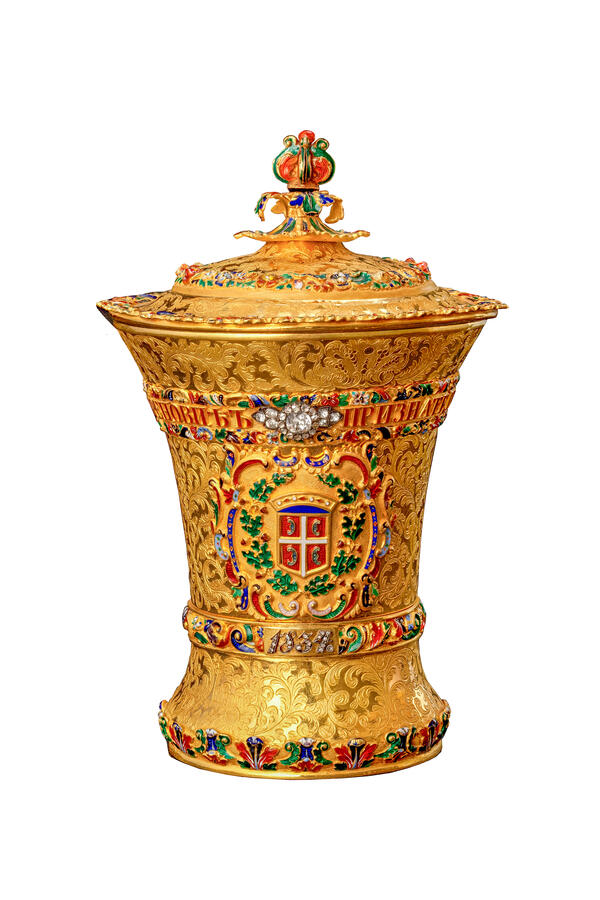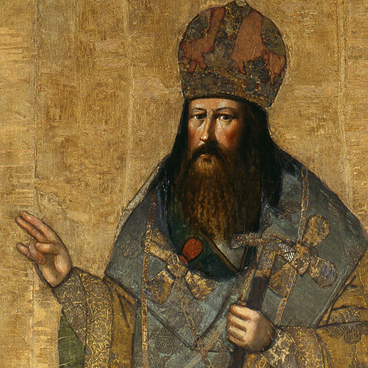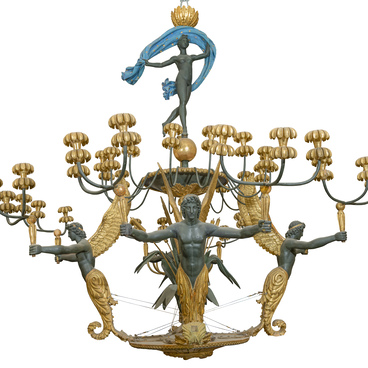The Serbian Prince Miloš Obrenović presented this commemorative cup with the image of the coat of arms of Serbia to the Russian diplomat Apollinary Butenyov in 1834. The history of this gift is connected with the events that unfolded in the Ottoman Empire in the early 1830s. At that time, the Turks were at war with Egypt, and the Turkish government officially turned to the Russian government for support in the fight against the Egyptian Pasha Mehmed Ali.
Three Russian squadrons were sent to the Bosporus Strait one after another. Such military support and diplomatic pressure from the Russian Empire forced Mehmed Ali to surrender. In 1833, Russia and Turkey signed the Treaty of Hünkâr İskelesi which proclaimed peace, friendship and defensive alliance between the two counties.
Earlier diplomatic documents stated that Russia supported the Christian Orthodox population of Turkey, in part by demanding the recognition of autonomous Serbia, which at that time was part of the Ottoman Empire. In reality, the Ottoman Empire had not honored these terms, and the Treaty of Hünkâr İskelesi provided an occasion for Russia to reinstate them. It contained an article confirming all previous agreements between Russia and Turkey, including the ones on Serbia. Following this, in the same year of 1833, the sultan’s firman (a decree) was issued, which, in agreement with the Russian side, finally established the political status and borders of Serbia, which was recognized as an autonomous principality. Prince Miloš Obrenović was proclaimed the hereditary ruler of Serbia.
The Treaty of Hünkâr İskelesi was signed on the Russian side by General Aleksey Orlov and the Russian ambassador to Constantinople, the Active Privy Councilor Apollinary Butenyov. In 1834, Miloš Obrenović thanked Butenyov for his diplomatic support and presented him with a memorable gift — a cup inlaid with precious stones with a lid, which is now housed in the State Historical Museum.
In the upper part of the cup one can see a commemorative inscription: “From the grateful Serbia and Prince Miloš Obrenović”. Below is the date — 1834 — and another inscription “To Apollinary Petrovich Butenyov”. The reverse side of the glass depicts the coat of arms of the newly reinstated Serbia: a red shield, a white Greek cross — a symbol of the Christian faith — and four firesteels.
Three Russian squadrons were sent to the Bosporus Strait one after another. Such military support and diplomatic pressure from the Russian Empire forced Mehmed Ali to surrender. In 1833, Russia and Turkey signed the Treaty of Hünkâr İskelesi which proclaimed peace, friendship and defensive alliance between the two counties.
Earlier diplomatic documents stated that Russia supported the Christian Orthodox population of Turkey, in part by demanding the recognition of autonomous Serbia, which at that time was part of the Ottoman Empire. In reality, the Ottoman Empire had not honored these terms, and the Treaty of Hünkâr İskelesi provided an occasion for Russia to reinstate them. It contained an article confirming all previous agreements between Russia and Turkey, including the ones on Serbia. Following this, in the same year of 1833, the sultan’s firman (a decree) was issued, which, in agreement with the Russian side, finally established the political status and borders of Serbia, which was recognized as an autonomous principality. Prince Miloš Obrenović was proclaimed the hereditary ruler of Serbia.
The Treaty of Hünkâr İskelesi was signed on the Russian side by General Aleksey Orlov and the Russian ambassador to Constantinople, the Active Privy Councilor Apollinary Butenyov. In 1834, Miloš Obrenović thanked Butenyov for his diplomatic support and presented him with a memorable gift — a cup inlaid with precious stones with a lid, which is now housed in the State Historical Museum.
In the upper part of the cup one can see a commemorative inscription: “From the grateful Serbia and Prince Miloš Obrenović”. Below is the date — 1834 — and another inscription “To Apollinary Petrovich Butenyov”. The reverse side of the glass depicts the coat of arms of the newly reinstated Serbia: a red shield, a white Greek cross — a symbol of the Christian faith — and four firesteels.



